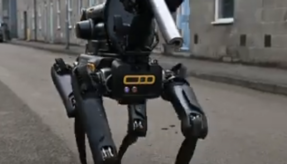
The Defence Science and Technology Laboratory (Dstl) is funding research into new super-thin materials that could mean front line troops have solar panel shirts and data storage in their combats.
Nicola Townsend is researching the properties of new super-thin materials for a PhD at the University of Exeter with Prof Saverio Russo and Prof Monica Craciu. The work was carried out with Dr Iddo Amit, a Research Fellow funded through the European Commission Marie Curie Actions.
Originally, Nicola was trying to find magnetic field sensors, but started looking at a layer-structured semiconductor that can be thinned down to thickness of a few atoms, making it truly two-dimensional.
The material, molybdenum di-telluride, is part of an exciting family of electronic materials that are promising to revolutionise the industry. Since the discovery of graphene, there’s been a push to discover new 2D materials. Most electronic gadgets are based on silicon but while it is very common, there are things – wearable electronics, smart textiles – where silicon, due to its structure, cannot be used. The new family of 2D materials offers transparency and flexibility, making them ideal for wearable tech.
The project was modified to look at the problems with implementing the new materials into everyday devices – and Nicola discovered that the problems could offer new solutions. Minute imperfections hinder the motion of charges in the material, requiring higher energy to operate them. Surprisingly, the same imperfections can also be utilised for advanced applications, like infrared photo-detectors or memory devices.
Real-world applications for this novel technology include flexible solar panels – on backpacks or integrated into clothes, which wouldn’t add any weight. There is also potential for infrared sensing as part of cameras, which can allow their use in smoke or harsh weather conditions, or to sense organic chemical signatures in real time on packaging.
Other opportunities could exist in communications, or for having data storage in clothing.
Nicola commented: “Graphene was only successfully isolated and measured 14 years ago, and by this sparked global interest in 2D materials. We’re only now starting to scratch the surface by looking into finding and exploiting these new materials. We’re working our way to mass production, but we can already see that this area has a huge potential.”
If you would like to join our community and read more articles like this then please click here.
Defence Science and Technology Laboratory Dstl graphene solar panel shirts







